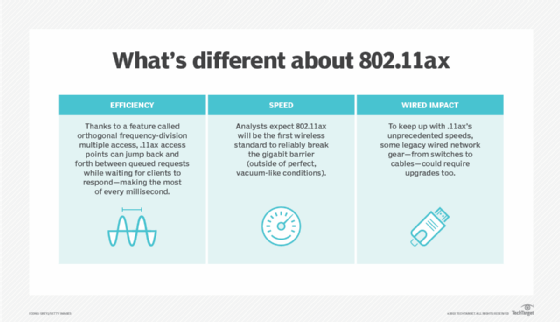
markrubens - Fotolia
Wi-Fi for IoT gives organizations low-cost connection option
The IEEE standard 802.11 serves as a low-cost option to connect IoT devices via Wi-Fi. Until the 802.11 Working Group further improves the standard, understand which IoT use cases it works best for.
With the rapid growth of IoT and the challenges of integrating emerging and legacy technology, Wi-Fi for IoT offers a simple and inexpensive standard option for IT pros.
IEEE 802.11 is the standard for wireless local area networking media access control and physical layer specifications, commonly known as Wi-Fi. Development teams use Wi-Fi for IoT sensors and devices mainly because of its ubiquity and extremely low cost. Organizations use the standard in many common IoT applications and consumer devices, such as networked thermostats, security cameras, utility meters and health sensors. Any connected device probably runs some implementation of the 802.11 standard.
How does Wi-Fi for IoT work?
Wi-Fi for IoT differs from other protocols and standards in its simplicity and scale. The 802.11 standard relies on a listen-before-talk protocol, making it strong and inexpensive. It doesn't require a centralized controller. Many component, system and service providers can use the standard to rapidly and economically deploy products and services.
The standard does have limitations when it comes to IoT devices, including limited range of up to 100 meters and power consumption. Members of the IEEE 802.11 Working Group are working to expand the range and capacity, as well as reduce power consumption to enable IoT sensors to operate for 10 years on a single small battery. Until the 802.11 Working Group improves the standard, organizations in need of greater range or low power operation might find the IEEE 802.15.4 Standard for Low Power Wireless serves them better.
How was IEEE 802.11 developed?
The foundation for wireless LANs can be traced back to when radio spectrum regulators, such as the Federal Communications Commission, carved out small chunks of radio frequency spectrum and established rules for unlicensed operation in 1985. The rules meant that devices could wirelessly operate without going through the arduous process of obtaining certification from the regulator and opened an opportunity for people to create and sell low-cost wireless devices. Shortly after that, IEEE 802 began work on through air media, which was wireless networking in 1987 within the 802.4 Token Bus Working Group. Soon it became clear a separate working group should develop a wireless LAN standard.

The 802.11 Working Group was born in 1990 by a small group of individuals with technical expertise in radio frequency system design, silicon, network interfaces, systems and networked applications. The group worked on the initial standard for seven years before it was ratified and published in 1997. Since then, the 802.11 Working Group has grown to hundreds of active participants making continual improvement on the original standard to get to the standard today and Wi-Fi 6, which has begun rolling out.








